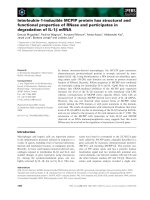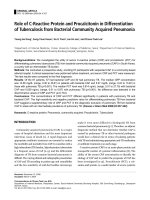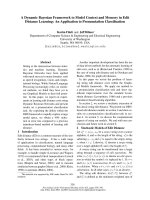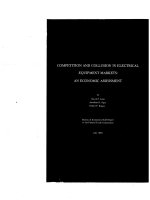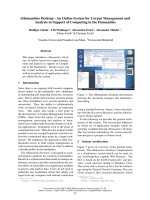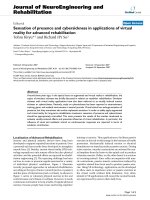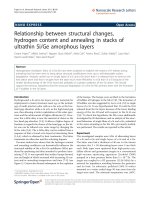SIMILE AND HYPERBOLE IN IDIOMS OF COMPARISON An implicaton for Vietnamese students studying English idioms of comparison
Bạn đang xem bản rút gọn của tài liệu. Xem và tải ngay bản đầy đủ của tài liệu tại đây (74.49 KB, 13 trang )
Vietnam National University, Hanoi
College of Foreign Languages and International Studies
DEPARTMENT OF POST GRADUATE STUDIES
***********
SIMILE AND HYPERBOLE IN IDIOMS OF COMPARISON
An implicaton for Vietnamese students studying English idioms of comparison
SEMANTICS
(Final assignment)
Hanoi- 2010
CONTENT
1. INTRODUCTION
2. DEVELOPMENT
2.1.
Simile and
hyperbole..........................................................................
2.1.1. Definition......................................................................................
.
2.1.1.1. Definition of simile...................................................................
2.1.1.2. Definition of hyperbole.............................................................
2.1.2. Analysis .......................................................................................
.
2.1.2.1.The four parts structure of simile and hyperbole
2.1.2.2. Simile in contrast with hyperbole
2.2.
Idioms...........................................................................................
.....
2.2.1. Definition......................................................................................
2.2.2. Classification................................................................................
.
2.2.3. Characteristic................................................................................
.
2.3.
Simile and hyperbole in idioms of
comparison.................................
2.3.1. Semantic roles of the comparison
elements...................................
2.3.2. Cultures features affecting simile and hyperbole.........................
3. IMPLICATION
4. CONCLUSION
1. INTRODUCTION
Language is explicitly crucial for communication and mutual
understanding. To communicate clearly, one of the most important factors is
that students must be able to identify and use figurative language correctly.
Figurative language is language that uses words or expressions with a
meaning that is different from the literal interpretation. When a writer uses
literal language, he or she is simply stating the facts as they are. Figurative
language, in comparison, uses exaggerations or alterations to make a
particular linguistic point. Figurative language is very common in poetry, but
is also used in prose and nonfiction writing as well.
There are many different types of figurative language. For
example:simile. metaphor. personification. hyperbole, idioms,.. These appear
in both English and Vietnamese.
English and Vietnamese both own a variety of idioms- the quite brief,
figurative way of expressing ideas that makes wonders out of normal words
and expressions. In any language, idioms plays a considerable role as idioms
contain language knowledge and culture knowledge as well. Therefore, it
would be inadequate for learners of English without idioms studies. To some
extent, knowledge of idioms may be regarded as one of the criteria to assess
learners’ deep understanding about the language.
Using transference of meaning in idioms is said to be common. Among
various transference of meaning types as mentioned before, hyperbole and
simile are used rather widely. However, it is not easy to distinguish these two
types as there is no explicit borderline between them.
Because of the reason above, I have no better choice but a desire for
taking the topic
Simile and hyperbole in idioms of comparison with an implicaton for
Vietnamese students studying English idioms of comparison in this final
assignment. This is made with the hope to giving a brief overview about
Simile and hyperbole in idioms of comparison. Also, I have an expectation
that this study would be a helpful reference for Vietnamese learners of
English sothat they could have a better understanding and efficient using of
English idioms of comparison.
All supervisor’s and readers’ comments are welcome.
Thank you so much!
2. DEVELOPMENT
2.1. Simile and hyperbole
2.1.1. Definition
2.1.1.1. Definition of simile
A simile is a figure of speech comparing two unlike things, often
introduced with the words "like", "as", or "than". Even though similes and
metaphors are both forms of comparison, similes allow the two ideas to
remain distinct in spite of their similarities, whereas metaphors compare two
things without using "like" or "as". For instance, a simile that compares a
person with a clock would go as follows: " He is as punctuate as a clock." A
metaphor might read something like, "When Chris ran, she was a speeding
bullet racing along the track. (From Wikipedia, the free encyclopedia)
“An explicit comparison using like or as, simile literally mean ‘like’ or
‘the same as’
(Jack Lynch- http://library. preservice.org)
2.1.1.2. Definition of hyperbole
Hyperbole is a rhetorical device in which statements are exaggerated.
It may be used to evoke strong feelings or to create a strong impression, but
is not meant to be taken literally. Hyperboles are figures of speech that are
exaggerated in order to create emphasis or effect. Hyperbole is a literary
device often used in poetry, and is frequently encountered in casual speech.
An example of hyperbole is: "The bag weighed a ton". Hyperbole helps to
make the point that the bag was very heavy although it is not probable that it
would actually weigh a ton. On occasion, newspapers and other media use
hyperbole when speaking of an accident, to increase the impact of the story.
This is more often found in tabloid newspapers, which often exaggerate
accounts of events to appeal to a wider audience. (From Wikipedia, the free
encyclopedia)
“Hyperbole is an exaggerated statement not meant to be understood
literally but the effect is powerful” (Hoa, Nguyen- 2001)
For example: “I nearly died laughing” or “ I tried a thousand times”.
2.1.2. Analysis
2.1.2.1. The four parts structure of simile and hyperbole
Grammatically, hyperbole and simile are the forms that represent two
proportions in a semantic structure. A proportion consists of two elements,
the topic and the comment on that topic. When a simile or a hyperbole
occurs, readers must analyse it by finding out the two proportions for an
insightful understanding. These two porportions are related to each other by
a comparison. The comparison appears in the comments and the proportions.
For example, in the simile “He fought as bravely as a lion”, there are two
proportions:
-
He fought bravely.(1)
topic
comment
A lion fought bravely.(2)
topic
comment
However, in an example of hyperbole such as “like a dog with two tails”
→ implicit 1st proportion, 2nd proportion: dog
topic
with two tails
comment
We can infer that a dog would be very proud of two tails and it looks
funny, too. That would make others have curious look towards him. As a
resutl, he must be embarrassed. This is the figurative meaning of the idiom.
Now, it becomes easier to decide what the 1 st proportion should be,
depending on the communicative purpose. In such a case, we have to
analyse the topic, the comment of the 2 nd proportion to find the image, the
point of similarity and the figurative meaning.
In general, to have a good understanding of simile and hyperbole, we
should make the two proportions explicit. By doing this, we would be able to
point out the topic (the topic of the 1st proportion- figurative), the image (the
topic of the 2nd proportion- figurative), the point of similarity (the two
comments of the proportions) and the nonfigurative meaning (the meaning
of the whole simile, hyperbole).
2.1.2.2. Simile in contrast with hyperbole
2.1.2.2.1. Similarities
Both simile and hyperbole are figurative language- means of stylistics
with the purpose of a more powerful effect. When a simile or a hyperbole
occurs, it would be very easy and effective for readers and listeners to
visualise the discussed matters. They both makes a full use of images in
expressing ideas in a very figurative way. For instance, we can either say
“He is very strong” or “ He is as strong as a horse”. However, the 2 nd way is
much more figurative, forceful with the use of definite image- a horse.
Therefore, simile and hyperbole both are preferable in daily conversations.
Generally, simile and are hyperbole comparisons or more exactly, simile
is a comparison while hyperbole commonly takes the form of comparison.
Simile and hyperbole often compare two things to find the similarity, and
then ask for a deep understanding from readers and when analysing them, it
is a must to find the four parts structures.
2.1.2.2.2. Differences
Simile is defined as “a comparison between two essentially unlike items
on the basis of a shared quality, similes are introduced by like or as”.
Meanwhile, hyperbole is considered as “usage of words or expressions to
exaggerate features with the purpose of highlighting them, causing
particularly powerful impressions”. Obviously, the term hyperbole has a
much wider scope as it can either take the form of comparison or not.
Regularly we use hyperboles such as “millions of promises” without the use
of comparative structures. A simile, in contrast, must take the form of
comparison, commonly it is the structure “as....as” or “like...”. It can be
concluded that the term hyperbole overlaps simile. However, a major part of
hyperboles compare two objects i.e take the form of comparison.
As a matter of fact, the distinguishing point between hyperbole and simile
is the sense ‘exaggeration’- an action of making something seem to be
larger, better, worse... than it really is. In a hyperbole, exaggeration
dominates such a major role that it becomes the hyperbole’s indicator. Let
take a look at the following example: “Her face went as white as the sheet
when she heard the news”. This sentence can be analysed as follow:
- Topic: Her face
- Image: a sheet
- Point of similarity:
white
- Nonfigurative meaning: she was very shocked, feared on hearing the
news
On the other hand, a simile takes no exaggeration. It simply is a
comparison of one item with another. Let have a look at the following
instance: “The old house stayed as firmly as a rock in the storm” with the
four part structure as follow:
- Topic: The old house
- Image: A rock
- Point of similarity:
stay firmly
- Nonfigurative meaning: The old house stayed as firmly as a rock in
the storm
It is obvious that no exaggeration is found since the image ‘a rock’
functions as an additional to the nonfigurative meaning of the sentence. With
the use of the comparative structure, the sentence is much more vivid,
figurative.Then, readers would find it easier to understand the meaning.
It seems to be rather complicated to distinguish simile and hyperbole as
the sense of exaggeration is not concrete and depends on individual views. A
comparison can be considered as exaggerating by one person or one culture
but not by others.
2.2. Idioms
2.2.1. Definition
An idiom is an expression used by a particular group of people with a
meaning that is only known through common use. One example of an idiom
would be to say, “I’m just waiting for him to kick the bucket.” Many idioms
that are frequently used are also considered clichés. (From Wikipedia, the
free encyclopedia)
“An idiom id the assigning of a new meaning to a group of words which
already have their own meaning” (Dean Curry-1995)
2.2.2. Classification
Basing on lexicology, idioms are devided into three types:
- Pharaseological Fusions
- Pharaseological Unites
- Pharaseological Combinations
According to Giap, Nguyen Thien- 1999, idioms are devided into two
types: Pharaseological Fusions and Pharaseological Combinations.
Pharaseological Fusions are idioms with the highest stage of blending
the idioms’ component together. There is no connection between the
meaning of the idioms and its components i.e the meaning of the idiom can
not be understood by the meaning of its components. It is a must to study the
idiom as a whole unit.
Pharaseological Unites are partially motivated idiom. The meaning of the
whole unit is not the sum of the components’ meanings but it is based on
them. We can deduce the general meaning from the components.
Pharaseological Combinations are explicitly motivated idioms as they
contain components used in direct meaning. In Pharaseological
Combinations, words retain their complete semantic independence despite
their being limited in combinative power.
2.2.3. Characteristic
- Stability of lexical structure
- Stability of grmmatical structure
- Stability of use
2.3. Simile and hyperbole in idioms of compariso
2.3.1. Semantic roles of the comparison elements
It has been widely accepted for ages that the general structure of a
comparison is A as B, of which A is the compared element, B is the
compared with element, as differ from languages to languages according
grammatical rules. However, there is an exception.
For example: “He is as fierce as tiger”
→ “He” is compared with “tiger” by their character “ fierce”
→ A is compared with B only by comparing their so-called similar
attributes, not the two elements themselves.
Then, the logical structure of a comparison should be: At as Bt
In linguistic structure of comparison, Bt is always seen under the form of
implication so the general and complete linguistic structure of comparison is
At as B or t as B or as B
In an idiom of comparison, from semantic view, the element t is socalled the needs-to-be-clarified-element and the element B is the used-toclarify-element when it has the attributes that can be used to clarify the t.
Such a relation is carried out by the grammatical element as.
In the t as B structure of an idiom of comparison, the appearance of the
element t is stable in the idiom’s semantic structure while in the comparisonthe lexical structure it is very flexible. In terms of meaning, the element t has
no concern to the figurativeness as it is simply the element with the literal
meaning.
Unlike the element t, the element as is also a standing element in the
lexical structure but it plays a minor role in semantic structure. In many
cases, the element as even has no semantic function but the grammatical
one only.
Contrastively, the element B brings either lexical or figurative meaning(s)
to the idiom. Researchers have shown that the element B in idioms of
comparison has at least three types of meanings as follow:
- t as B of which t at a definite grade, of a manner and under the speaker’s
judgement
- t as B: How t – the states, definite property of t under speaker’s judgement
- as B: being in the state or having the property that is reflected by B
2.3.2.Cultures features affecting simile and hyperbole
From the analysis of simile and hyperbole, we have proved that the root
of the difference between them is exaggeration. However, since exaggeration
is an abstract term, it turns out to be the speaker’s judgement and attitude
that decide what is exaggerated and what is not. With the same image of
comparison, it can be considered as exaggeration by this person but not by
that one.
In the study on idioms of comparison, we find that the element B
dominates the key role and only by analysing the element B can we work out
the grade, the manner, the speaker’s judgement and attitude towards what is
being discussed in the element t.
Besides, the speaker’s judgement is directly affected by the culture
settings and features. The same image can be of positive judgement in this
culture but negative in another.
Cuture study have shown that the English is typical for their analytic
ways of thinking. English people keep on examining carefully all the
concern matters for an insightful understanding. In their mind, everything
must be accurate and detailed. Such analytic way of thinking is best
exemplified in the English grammar, the direct talking manner, the punctuate
habit... and it directly has influence on simile and hyperbole in idioms of
comparison.
3. IMPLICATION
Teaching figurative language especially idioms of comparison can be a
challenge on many different levels. For example:
- Small children find figurative language difficult because they lack the
intellectual capacity to realize that words can have more than one meaning.
- People who are learning English as a second language find many types
of figurative language to be challenging because of their vocabulary
limitations.
It is not easy to solve these problems at once but with the theory
presented above, I hope that Vietnamese learners would be provided with a
useful brief document to have a more explicit understanding about the use
of simile and hyperbole in English idioms of comparison.
4. CONCLUSION
Idioms are said to be the major part of any language that have been
attracting scholars, learners to study. With the simple aims of having s
deeper understanding about idioms with their figurative meanings and
stylistic methods for a productive application in daily converstion, future
teaching career and also with a small ambition to study on this matter, I have
found that English is rich in idioms and once they are used, the speech
becomes very figurative.
The study has also pointed out that the most typical feature to
distinguish simile and hyperbole is exaggeration. However, since
exaggeration is an abstract psychology term, the study stated that cultural
features had an important influence on simile and hyperbole in idioms of
comparison. They are the speakers’ way of thinking and lifestyle.
REFERENCE
1. Dean Curry- Illustrated American Idioms (1995)
2. Jack Lynch- Guide to literary term (http://library. preservice.org)
3. Wikipedia, the free encyclopedia

